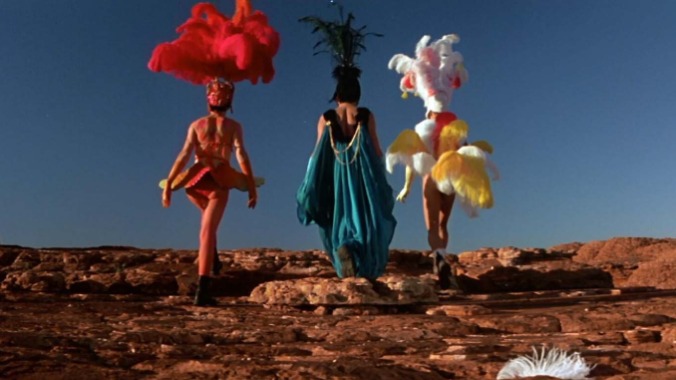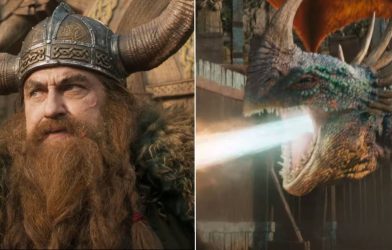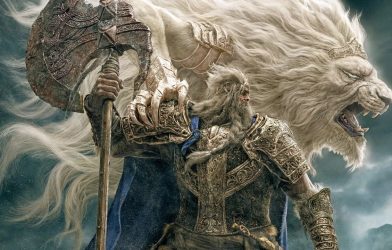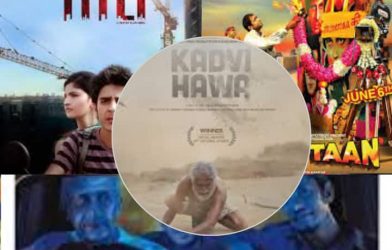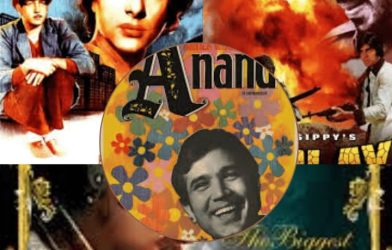Welcome to The Weekend Watch, a weekly column focusing on a movie—new, old or somewhere in between, but out either in theaters or on a streaming service near you—worth catching on a cozy Friday night or a lazy Sunday morning. Comments welcome!
We’ve tackled punk riots, evil British laws, artistic crushes and crushing one-man shows, but our final Pride weekend of 2024 should be spent on a glorious, celebratory queer film: The Adventures of Priscilla, Queen of the Desert. Stephan Elliott’s Oscar-winning Aussie classic offers three blistering lead performances (from Terence Stamp, Hugo Weaving and Guy Pearce), some truly ostentatious design across the board and a heartwarmingly nuanced story that had its heart right back in 1994. You can find it on any of the ad-supported free streamers (like Tubi, Freevee, Roku, or Pluto TV) as well as on Peacock and your library streaming service.
How three renowned cis actors turned two drag queens and an older trans woman into the magnetic center of this flamboyant road trip still boggles my mind. Though it has a similar premise to the equally warm (but far more broad) American film To Wong Foo, Thanks for Everything! Julie Newmar, which would feature Wesley Snipes, Patrick Swayze and John Leguizamo as cross-country queens a year later, The Adventures of Priscilla, Queen of the Desert is much sharper in its communal specificity and compassionate in its depictions of rural straights dazzled by the fabulous trio. And it has as much to do with the script as it does with the committed, complex central performances.
The bickering bitchiness between Pearce’s flashy Felicia and Stamp’s worn-out Bernadette (with Weaving’s expressive Mitzi playing intermediary) never shies away from realistic harshness—even transphobia. Felicia deadnames Bernadette, because Felicia is young and stupid and trying to get a rise, and knows that this is a weapon. And, as Felicia has all the capital associated with being the youngest, hottest, thinnest, tannest gay in the group, he’s a little jerk about it. Obviously. But that feels true, just as it feels true that the group’s gossipy, chatty, sing-song rapport always has room for love.
This prickly point is just one keen observation of queer life made by Elliott. The writer/director’s script notes, among other phenomena, the prevalence of chasers (who Bernadette is well-familiar with), the anxiety one may experience bringing up any closeted life decisions around the out-and-proud crowd and the particularly strange relationship that ultra-masc Australia has with drag. The rapid-fire screenplay never quits quipping, laughing, sniping. Its characters have seen all this before, and assume we have too. The Adventures of Priscilla, Queen of the Desert therefore grows beyond its grabby, flashy, gaudy premise—and its fulfilled promise of big costumes, garish make-up and exaggerated lip-syncs. It becomes an observation of its country’s homophobia, of the rural-urban divide, of aspirational acceptance from all walks of life, be they bumbling straight mechanics or your own young son.
This optimism is a big part of why Priscilla still lands so strongly today. Though it doesn’t deny the potential for queerbashing violence (something it deals with so viscerally that George Miller used it as an example in his doc about the history of Aussie cinema), the film believes in its normies. It doesn’t delude itself; Elliot fills the movie with hilarious reaction shots of gape-mouthed yokels. But it does offer the chance for said yokels to rise to the occasion. Some drink heavily with the performers, some fall in love with them. A group of Aboriginal Australians even participate in one of the trio’s lip syncs…though this bleeds into the one area (race) where Priscilla’s attitudes show their age.
The ultra-happy, ultra-accepting campfire party of Aboriginal Australians, who accompany “I Will Survive” on the didgeridoo, have their broad-strokes stereotypical depiction contrasted with a caricatured Filipina, whose vulgar cartoonishness is so unpleasant that, once the credits roll, you just want to forget she was ever in the movie at all. This all, perhaps, would’ve landed even worse had the filmmakers been able to go forward with their initial plan, which was to end the film with the queens summiting the sacred national landmark Uluru. Better (and funnier) that they stuck to Kings Canyon.
While The Adventures of Priscilla, Queen of the Desert has its flaws, its focus on its central trio is overbearingly loving. It loves drag (the bus the three tour in is topped by a massive high-heel), it loves color and excess, and it loves the community that lifts up its members while trading barbs. By the time “Mamma Mia” plays, you feel like you’ve known them for years, loving every campy second—while thoroughly invested, earnestly, in everyone’s life. High irony and simple drama dress up as each other, creating a feature-length drag performance as entertaining as has ever been filmed.
Jacob Oller is Movies Editor at Paste Magazine. You can follow him on Twitter at @jacoboller.
For all the latest movie news, reviews, lists and features, follow @PasteMovies.

